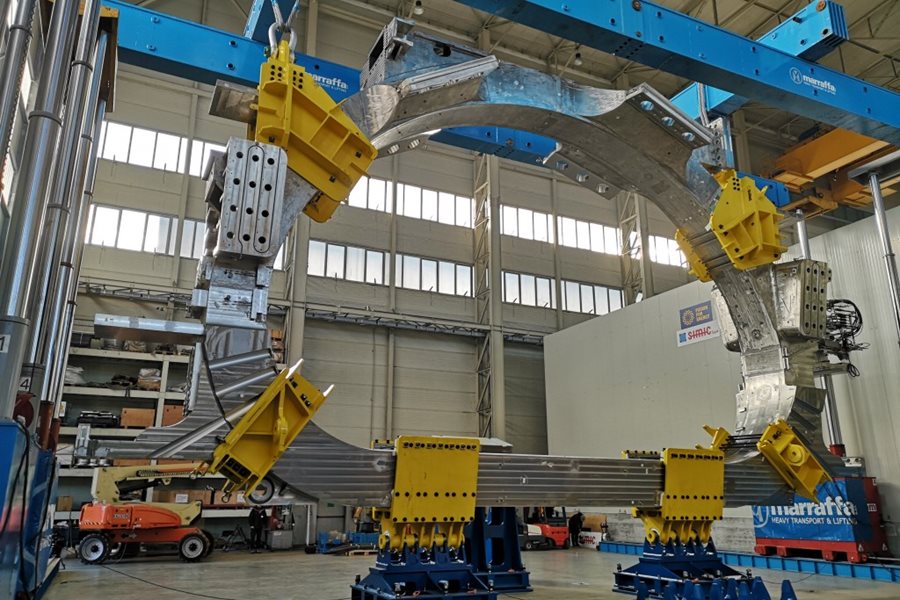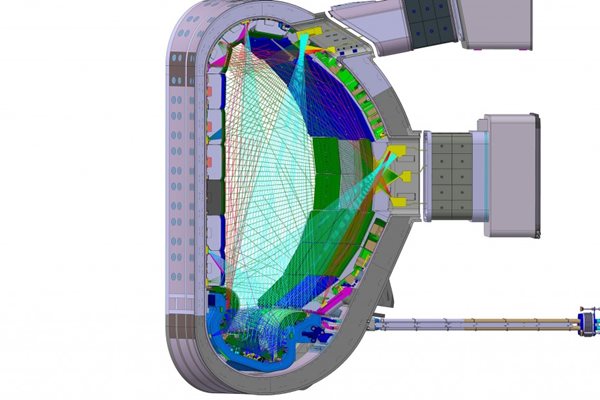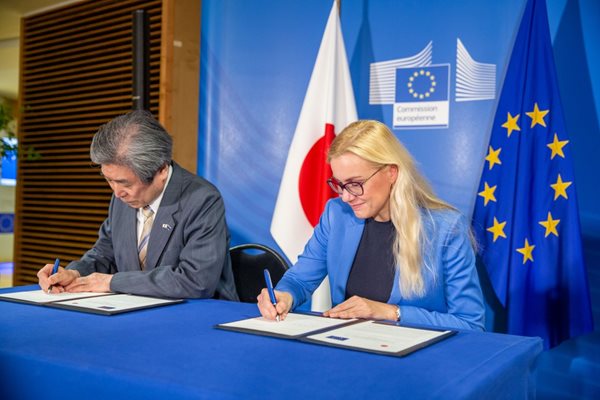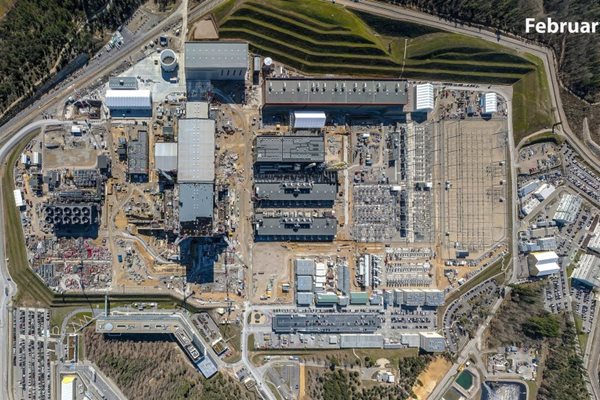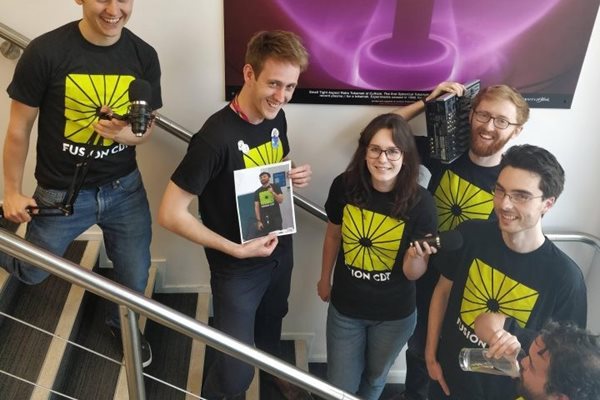
you're currently reading the news digest published from 02 Mar 2020 to 09 Mar 2020
featured5
of-interest1
video1
press5
featured
Industrial milestone | Europe completes D-shaped magnet
The first of 10 toroidal field coils to be procured by ITER's European Domestic Agency, Fusion for Energy, is ready for shipment. This is the first deliverable of a decade-long program involving more than 700 people and 40 companies. Following successful factory acceptance tests on 11 February, this major ITER component was cleared for final packing and shipment. The 320-tonne component is scheduled to leave from the Italian port of Marghera (Venice) by 11 March and arrive in Fos-sur-Mer, France, on 17 March. After transfer first by barge and then by road along the dedicated ITER itinerary, the D-shaped magnet will be delivered to ITER on 3 April. "Europe's magnet will be the first of the 18 toroidal field coils to be delivered to ITER, and will also be the first European component of such size to be handed over to the project," said the agency in a press release published on 9 March. Fusion for Energy has worked closely with European industry at every stage of the process: Luvata (copper strand); Oxford Instruments Superconducting Technology and Bruker European Advanced Superconductors (niobium-tin strand); the ICAS consortium (ENEA, Tratos and Criotec) for conductor cabling, jacketing and spooling; CNIM and SIMIC for radial plate manufacturing; the ASG consortium (ASG Superconductors, Iberdrola Ingeneria, Elytt Energy) for the creation of the superconducting winding pack; and finally SIMIC and subcontractor Babcock Noell for the final production steps (including cold testing, insertion of the winding pack into a structural steel case, and closure welding and machining). In all, 700 people from at least 40 companies took part. Eighteen "D"-shaped toroidal field magnets placed around the ITER vacuum vessel will produce a magnetic field whose primary function is to confine the plasma particles. The toroidal field coils are designed to produce a maximum magnetic field of 11.8 tesla and store 41 gigajoules of energy. Weighing over 300 tonnes and measuring 9 x 17 m, they are among the largest components of the ITER machine. The European Domestic Agency is responsible for the procurement of ten toroidal field coils; the Japanese Domestic Agency is producing eight complete coils plus one spare, as well as all structural steel cases. (ITER Japan's first coil left Kobe port last week.) Once delivered to the project, ITER's construction teams will take over to prepare the magnet coils for assembly. Mechanical preparatory activities include welding cooling pipes and cable trays, attaching clamps to support other coils, and welding interfaces. See the full story and press releases in English, Spanish or Italian here. Download the toroidal field coil poster. See this video on coil manufacturing.
Bolometers | Diagnostics for maintaining the power balance
One hundred bolometer sensors, with a total of around 500 lines of sight, will be strategically placed around the ITER Tokamak to continually measure the total radiation and radiation profiles, and to provide the plasma control system with some of the information it needs to control the ratio of incoming heating power and outgoing radiated power at the desired level. To maintain the optimal power balance in the ITER Tokamak, the plasma control system needs to know not only how much heat is coming out, but also which of the possible ways it is coming out: conduction and convection, electromagnetic radiation—or through neutrons. The goal is to reduce conduction and convection heat, and increase radiated heat, to the point that 90 percent of the power loss (not counting the neutrons) is electromagnetic radiation. Electromagnetic radiation heat has the advantage that, like the neutrons, it dissipates over a wider area in the tokamak (over 800 square metres) as opposed to conduction and convection heat, both of which concentrate their heat mostly on the divertor (an area of less than 100 square metres). 'One difficulty in maintaining the right percentage of radiated power is that the closer you get to this 90 percent goal, the higher the risk of going up to the 100 percent line, which would lead to a radiative collapse of the plasma,' says Roger Reichle, Ex-Vessel Diagnostics Section Leader. 'Bolometers¹ allow us to walk this fine line: not only do they measure the total amount of radiation with good precision, but they also measure the radiation pattern, which uniquely identifies the different operating conditions.' The bolometers deliver these observations to the plasma control system, which can then initiate any necessary adjustments. If radiation heat is below 90 percent, the control system may pump more impurities into the plasma to increase radiation. If it is above 90 percent, it may either reduce the impurities or increase the heat input through external heating. Bolometers and sparse data tomography Bolometers were invented nearly 150 years ago, and have since been applied in a number of domains—for example in astronomy to detect very faint changes in radiation. A basic bolometer consists of a thin strip of metal that absorbs radiation and heats up. The resistance of the metal strip is then measured to determine how much radiation has been absorbed. The bolometers ITER will use are miniaturized metal resistor bolometers. Thin film metal absorbers (up to 20 µm thick), deposited on top of very fine membranes (3 - 25 µm thick, depending on the substrates and manufacturing techniques) capture integrally the light emitted by the plasma over most of the relevant spectral range (from the near infrared to the soft x-ray range). A meander-shaped metal conductor on the backside measures temperature changes through changes in electrical resistance. To compensate for changes in ambient conditions, two absorbers will operate jointly in a bridge circuit, with one of the absorbers shielded from the plasma radiation to serve as reference (heated by the environmental heat—a combination of nuclear radiation and ambient temperature). One of the more demanding requirements on the ITER bolometers is that they must provide data readings within 1 millisecond. This drives the design towards thin membranes, which have lower heat transfer time. Another distinction is that ITER bolometers have to be robust enough to operate in a vacuum with high neutron fluxes and ambient temperatures exceeding 200 °C. They have to withstand a number of loads, including seismic loads and water and steam ingress due to water leaks, electromagnetic loads and associated forces during disruptions, and pressure pulses from massive gas injections to mitigate disruptions. These robustness requirements generally drive the design towards thicker membranes. To get a complete picture of the radiation profile, the arrangement of bolometers is optimized for tomographic reconstruction using around 500 lines of sight crisscrossing the plasma in a very well-thought-out pattern to obtain the best possible tomographic image of the radiation. Compared to other tomography applications (such as medical X-ray tomography), 500 lines of sight is a small number, and can produce only a relatively coarse tomographic image without any prior knowledge of the patterns to detect. By contrast, tomography performed on the human brain uses millions as it moves a camera with thousands of lines of sight incrementally around the cranium, producing a very sharp picture without any prior knowledge of the patterns to reconstruct. 'What we do is called sparse data tomography,' says Reichle. 'This is sufficient for us, because we only want to know about four or five features—and we know what the degrees of freedom are. Since the plasma flows along magnetic flux lines, we know that there will be relatively little change of radiation intensity in the direction of flux lines, but significantly more variation may occur perpendicular to these flux lines. Similarly, in the divertor region, the local variations can be significantly higher than in the bulk of the plasma and we have to detect the details there, which is the reason the highest concentration of lines of sight is in the divertor. It's a bit of an art to do tomography with so few lines of sight.' Essential calibration procedures Sparse data tomography is not the only area that calls for an artistic hand. Keeping the bolometers operating during a 30-minute pulse and then re-calibrating them for the next experiment will also require a delicate touch. 'One challenge is that during operation of the machine, the heat generated during an experiment will cause the environment to heat up,' says Hans Meister of the Max Planck Institute for Plasma Physics, project leader of the consortium that designs the ITER bolometer. 'So we'll have to determine before every plasma discharge the temperature-dependent calibration parameters to avoid any long-term slow drift. Fortunately, though, the calibration procedure is straightforward. We just send a specific amount of electrical voltage onto the resistors, which heats up the absorber. The resulting exponential decay of the temperature of the absorber, measured by the resistance underneath, makes it possible to determine the calibration constants of the bolometers.' 'However the long discharge times in ITER also result in temperature changes of the environment in between calibrations and thus call for additional measures,' Meister points out. 'Recording not only the voltage but also the current through the bridge circuit enables us to devise the required schemes for calculating the temperature changes and compensations for the change in calibration parameters.' ¹ A bolometer (from the ancient Greek ballein, to throw, to send) is a device for measuring the power of incident electromagnetic radiation via the heating of a material with a temperature-dependent electrical resistance.
Europe-Japan | An even Broader Approach
On 2 March, the European Atomic Energy Community (Euratom) and the Japanese government signed a joint declaration for the second phase of the Broader Approach activities, agreeing on further cooperation on research and development in the field of fusion energy. 'The ITER Organization welcomes this extension of the Euratom-Japan collaboration on ITER Broader Approach activities, which support and complement the ITER Project. It will help to intensify the cooperation between two of the major partners of the project in technical domains of relevance to ITER,' said ITER Director-General Bernard Bigot. Signed in 2007, the Broader Approach agreement set into motion three projects, all located in Japan, with the joint investment of Euratom and the government of Japan (represented by its Ministry of Education, Culture, Sports, Science and Technology, MEXT). Since then, the agreement has been developed collaboratively by its implementing agencies Fusion for Energy and the National Institutes for Quantum and Radiological Science and Technology (QST). One of the Broader Approach projects, the JT-60SA tokamak, will be the largest tokamak in the world when it begins operating this year. The team based in Naka will conduct research on key physics issues for ITER and DEMO such as the development of optimized operational regimes; questions of stability and control, transport and confinement, and high-energy particle behaviour; pedestal and edge physics; plasma-material interaction; fusion engineering; and theoretical models and simulation codes. Even before then, however, the experience of assembling, installing, commissioning and starting up JT-60SA will be highly valuable for the ITER Organization. Ensuring that ITER fully benefits from JT-60SA returns on experience was the objective of a trilateral arrangement signed last November between the ITER Organization and the Broader Approach implementing agencies. The collaboration arrangement foresees the exchange of data and information; the exchange of scientists, engineers and other technical experts; the exchange of equipment, materials and instrumentation; and jointly performed experimentation, including remote participation. Phase II of the Broader Approach projects will focus on the operation and exploitation of the three projects that have been established, to the benefit of both parties. The teams will also be cooperating more closely than ever with ITER as the project advances steadily towards First Plasma in 2025. For more information on the Broader Approach, see this brochure edited by the European Commission or the QST website for information in Japanese.
ITER International School | Open for abstracts
The next ITER International School will be held from 20 to 24 July 2020 in France. Registration and abstract submission opens today. For the eleventh time, early-career scientists and engineers will be given the chance to interact with leading specialists from research organizations within the ITER Members and from the ITER Organization during an annual event that has become a reference among educational seminars in high-level fusion sciences. The ITER International School is organized for five days around a specific theme. This year's topic is "The Impact and Consequences of Energetic Particles in Fusion Plasmas"; topics and presentations from the ten previous editions can be consulted on the ITER website. All information about registration and abstract submission is available on this page of the IIS2020 website. The conference poster is also available with full information on speakers and presentations. Visit the conference website here.
Image of the week | More than meets the eye
Eight months separate these two satellite-like images of the ITER site. In July 2019, nine years into construction, concrete pouring had reached the seventh and final level (L5) in the Tokamak Building but the edifice was still roofless—the first pillar of the steel structure would only be installed in September. Eight months later, the roof is completed, and so is the first layer of cladding on the three sides of the building. To the left, in the July 2019 image, the cooling cells in the heat rejection zone are still under construction and piping and pumps are not yet installed. Adjacent to the heat rejection zone, the batching plant is still active, producing the last of the 250,000 cubic metres of concrete that were needed for building construction. Now that 75 percent of civil works to First Plasma is complete, the volume of concrete needed is only a fraction of what it used to be. The batching plant has been dismantled and the production of a local facility in nearby Vinon-sur-Verdon will be sufficient to cover present and future needs. In terms of worksite progress there is, however, more than just meets the eye: in July 2019, when ITER and its Indian partners celebrated the finalization of both the cryostat base and lower cylinder, the upper cylinder was in the early stages of assembly and welding. Last month, workers were busy cleaning the finalized upper cylinder prior to wrapping it into its protective cocoon. Assembly preparations are accelerating. In July 2019, the different parts of the upending tool, manufactured in Korea, had not yet taken to the sea. Now, the fully assembled tool is being maneuvered and tested. And in every building, unseen by the peering eye of the drone hovering above the platform, equipment installation is progressing quickly, bringing ITER closer to its first major appointment with history—the production of First Plasma in less than six years.
of-interest
Fusion podcast: Plans for STEP, the newest tokamak on the block
The latest 30-minute episode of the fusion podcast A Glass of Seawater discusses plans for a new compact fusion reactor at the Culham Centre for Fusion Energy. In October 2019, the UK government announced a £220 million funding package for the concept design phase of STEP—the Spherical Tokamak for Energy Production. Building on the operation of the new MAST Upgrade spherical tokamak experiment and on ITER, the program aims to design and build a commercially viable fusion power station by 2040. Ian Chapman, CEO of the UK Atomic Energy Authority, joins doctoral researchers from the Fusion CDT* program to discuss the hopes and ambitions for STEP. * Five UK universities—Durham, Liverpool, Manchester, Oxford, and York—have joined within FUSION CDT to offer doctoral training in fusion-relevant disciplines such as plasma physics, material science, nuclear physics, technology, laser physics, and instrumentation. Listen to A Glass of Seawater's "STEPisode" episode here. Learn more about Fusion CDT here.
